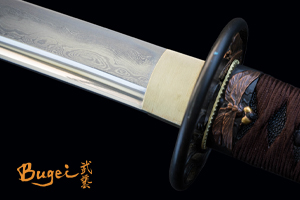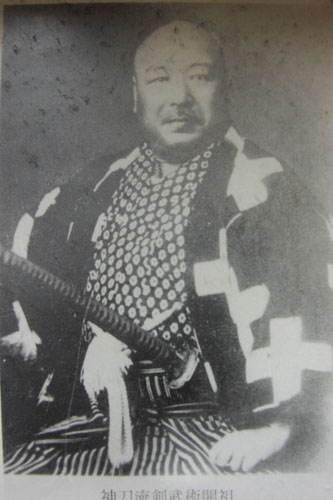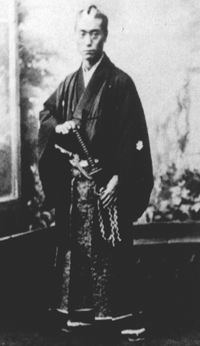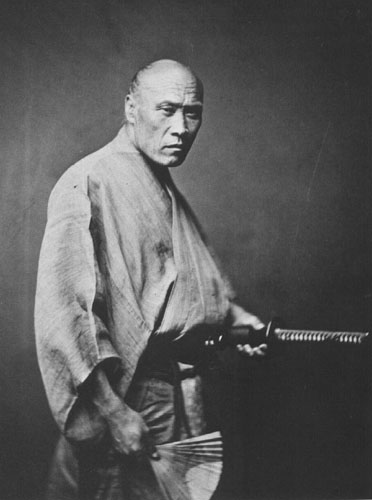
At Bugei, our interest is in the swords of the ancient Samurai. The shapes, lengths, nakago, tsuka, etc. reflect an era when swords were still used for combat. Our swords are used by more modern sword styles and our Wave koshirae blades can be custom designed to fit more modern styles that are currently practiced in Japan, however this is not our prime directive.
Most of the modern swords produced in Japan would not be practical for the uses that the Samurai required of their blades. The majority of currently produced blades are too thin and flat ground to stand up to the rigors of actual battle use. In real world terms a broken sword often meant death. In the 1850's in Japan two samurai were killed in different incidents because their swords broke during fights. One of these samurai was Nakai Shogoro killed at the Teradaya Inn and the other, named Arima, was killed at the Tenmanya Inn.
All cultures tend to rewrite history and the Japanese are no exception. Some modern styles for instance do not want to see things like tameshigiri become a more practical training for combative type of cutting and a more realistic test of blade performance. Modern Japan and the vast majority of modern Japanese martial arts, with some exceptions, do not reflect combat intent or function and only partially reflect the military arts of the Samurai. With this in mind we are drawn to the styles of blade and the military arts that reflect the Samurai when they were masters of their own fate.
The Edo period was the beginning of the end for Samurai martial culture, the Meiji restoration put nails in the coffin, and World War Two with a few notable exceptions put the coffin in the ground. In ancient Japan the size, shape, and styles of blades had a wonderful diversity that is missing in the present. We are interested in reproducing some of these swords for both the collector and the practitioner. Our desire is to produce, at the best possible prices, swords that reflect those ancient traditions that fire our imagination with the skill and courage of the Samurai in battle.
Our long nakago and two mekugi provide both strength and safety. Our choice of tsuka lengths from 11" to 13" provide for styles both ancient and modern.
CAS Iberia and Bugei Trading are joining forces to continue the legacy of the Bugei name earned over nearly 30 years leading the Samurai sword market. After the retirement of a founding partner, James Williams and his son, Christopher, plan to continue to develop samurai swords of the highest standard to Bugei’s own specification. CAS Iberia proudly partners with Bugei by being the new headquarters and worldwide distributor for the brand from Sale Creek, TN USA.
The first step in the CAS-Bugei partnership is the continuation of the current line of Bugei swords. The second step is a new sword project, the Mukade Katana, which will be revealed at Blade Show 2019. The Mukade project is a truly continent spanning collaboration as the design and concept are by James and Christopher Williams with fittings brought to life by renowned metal artist Roman Urban. A 10-piece limited edition of the exceptional Mukade is being made by Paul Chen’s son, Ron Chen, as a sole authorship project of his own forge in Taiwan. A semi-production Mukade sword crafted by the Hanwei forge will be released before the end of the year. A second sword project is currently in development designed by long time Bugei collaborator Keith Larman which will follow soon after.
Founded by James Williams in 1993, Bugei Trading along with then newly completed Hanwei forge by Paul Chen brought the first functional production samurai swords to the US market. Shortly thereafter Barry Ross, President and founder of CAS Iberia, began working with Paul to expand the range of Hanwei’s smiths by tasking them to produce functional, affordable reproduction European swords and Japanese style swords of Paul’s own design. Ever since the Hanwei forge has produced the Bugei and CAS range of swords side-by-side, it seemed only natural to solidify our partnership.
About Long Tsuka

We get many questions in regards to our katana having longer tsuka. To answer this we have been acquiring pictures of Samurai from the very late Edo period who have longer tsuka than are used in most of the modern Japanese martial arts.
Even though this was not a time of war, as in the old days, there was a great deal of social turmoil and fighting taking place. Drawings from earlier eras also depict longer tsuka. These longer handles were not necessarily on O-gatana like those used by the Kage ryu. Keep in mind that average Samurai height was much shorter than modern Westerners, so proportions can appear misleading in photographs.
Q. Does the longer handle make it difficult to use the sword one handed?
A. In our experience the longer handle actually makes it easier to use the blade one handed. It shifts the balance point closer to the hand and allows the user to brace the tsuka against the forearm if needed.
Q. Does the longer handle make it harder to do Iai-do/Iai-jutsu?
A. Iai—both in its Do and Jutsu forms—is broad and diverse. In dojo settings, our longer tsuka katanas have been actively used in practice and seminars, demonstrating exceptional speed, precision, and control—even by practitioners accustomed to shorter tsuka lengths.


Understanding Niku
Niku literally translates to "meat". It's a term used to describe the rounded cross-section or "bulging" sides of a traditional Japanese blade. It is not the same as kasane (blade thickness)—a thin blade can still have niku if its sides are rounded.
Historically, blades had significant niku to withstand use in combat. As blades were polished over time, that niku would wear down. A blade with little or no niku today may have once had much more—and its absence can tell us how much the blade has been worked on.
The presence or absence of niku affects tameshigiri performance and reveals much about historical function. The topic is deep and nuanced—and speaks to how function influenced form in ancient Japan. These reflections are shared from the perspective of a practitioner and collector, not a final authority—but as food for thought and conversation.
Click here to browse all items currently available from Bugei